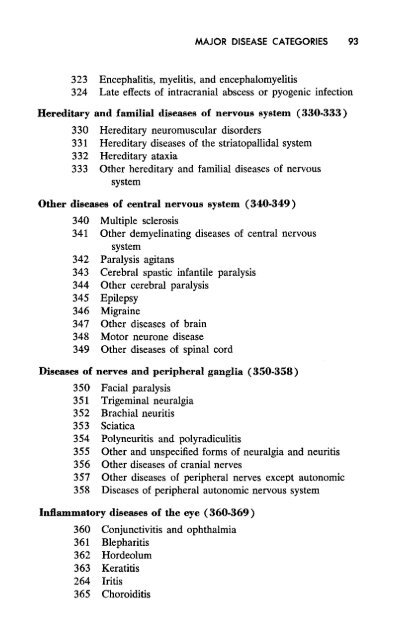DSM+II+1968
DSM+II+1968
DSM+II+1968
You also want an ePaper? Increase the reach of your titles
YUMPU automatically turns print PDFs into web optimized ePapers that Google loves.
DEFINITIONS OF TERMS 39<br />
expected to complete a differential diagnosis for patients who<br />
manifest features of several psychoses.<br />
IV. NEUROSES (300)<br />
300 Neuroses<br />
Anxiety is the chief characteristic of the neuroses. It may be felt and<br />
expressed directly, or it may be controlled unconsciously and automatically<br />
by conversion, displacement and various other psychological<br />
mechanisms. Generally, these mechanisms produce symptoms experienced<br />
as subjective distress from which the patient desires relief.<br />
The neuroses, as contrasted to the psychoses, manifest neither gross<br />
distortion or misinterpretation of external reality, nor gross personality<br />
disorganization. A possible exception to this is hysterical neurosis,<br />
which some believe may occasionally be accompanied by hallucinations<br />
and other symptoms encountered in psychoses.<br />
Traditionally, neurotic patients, however severely handicapped by their<br />
symptoms, are not classified as psychotic because they are aware that<br />
their mental functioning is disturbed.<br />
300.0 Anxiety neurosis<br />
This neurosis is characterized by anxious over-concern extending to<br />
panic and frequently associated with somatic symptoms. Unlike<br />
Phobic neurosis (q.v.), anxiety may occur under any circumstances<br />
and is not restricted to specific situations or objects. This disorder<br />
must be distinguished from normal apprehension or fear, which occurs<br />
in realistically dangerous situations.<br />
300.1 Hysterical neurosis<br />
This neurosis is characterized by an involuntary psychogenic loss<br />
or disorder of function. Symptoms characteristically begin and end<br />
suddenly in emotionally charged situations and are symbolic of the<br />
underlying conflicts. Often they can be modified by suggestion alone.<br />
This is a new diagnosis that encompasses the former diagnoses "Conversion<br />
reaction" and "Dissociative reaction" in DSM-I. This distinction<br />
between conversion and dissociative reactions should be<br />
preserved by using one of the following diagnoses whenever possible.<br />
300.13* Hysterical neurosis, conversion type*<br />
In the conversion type, the special senses or voluntary nervous<br />
system are affected, causing such symptoms as blindness, deafness,


